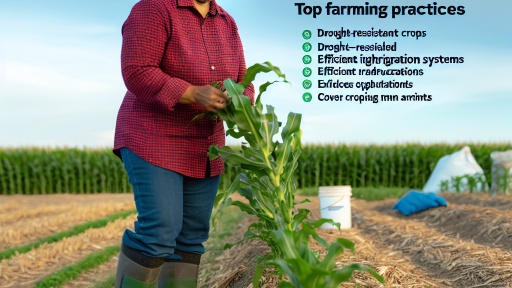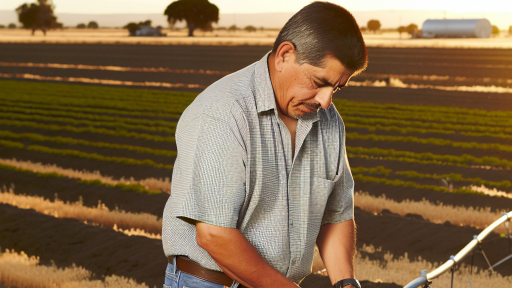Understanding Climate Change: Impact on Agriculture and Farming Practices
Climate Change and Its Effects
Climate change poses significant challenges to agriculture.
Rising temperatures directly affect crop yields.
Changes in precipitation patterns create water scarcity issues.
Extreme weather events increase the risk of crop failure.
Farmers must adapt to these unpredictable changes.
Shifts in Growing Seasons
Altered temperatures influence growing seasons significantly.
Some regions experience earlier springs and delayed winters.
These shifts can affect planting and harvesting schedules.
Farmers need to adjust their practices accordingly.
Soil Health and Fertility
Soil is a vital resource for farming.
Climate change impacts soil quality and fertility.
Increased rainfall can lead to soil erosion.
Dry spells may contribute to desertification in some areas.
Maintaining soil health becomes critical for sustainable farming.
Pest and Disease Proliferation
Warmer temperatures can expand pest habitats.
Transform Your Agribusiness
Unlock your farm's potential with expert advice tailored to your needs. Get actionable steps that drive real results.
Get StartedCrops become more susceptible to invasive species and diseases.
Farmers must implement integrated pest management strategies.
This proactive approach helps mitigate potential losses.
Water Resources and Irrigation
Water availability is increasingly unpredictable.
Excessive rainfall may result in flooding, while droughts lead to scarcity.
Farmers can adopt efficient irrigation methods to optimize use.
Rainwater harvesting can also enhance water resource management.
Market and Economic Implications
Climate change affects market prices and availability of crops.
Supply chain disruptions can lead to financial instability.
Farmers must diversify their crops to mitigate risks.
Engaging in local markets can enhance economic resilience.
Policy and Support Frameworks
Government policies play a crucial role in supporting farmers.
Incentives for sustainable practices can promote resilience.
Research and development must focus on climate-smart agriculture.
Strong networks among farmers encourage knowledge sharing.
Key Principles of Climate Change Adaptation for Farmers
Understanding the Impact of Climate Change
Climate change significantly affects farming practices worldwide.
Shifts in temperature alter crop growth patterns.
Increased frequency of extreme weather events disrupts production.
Moreover, changing precipitation patterns can lead to water shortages.
Implementing Diversified Crop Strategies
Diversifying crops enhances resilience against climate variability.
Consider planting drought-resistant varieties to cope with water scarcity.
Additionally, rotating crops can improve soil health.
This practice also minimizes pest and disease pressures.
Enhancing Soil Health
Healthy soil retains moisture better and supports plant growth.
Showcase Your Farming Business
Publish your professional farming services profile on our blog for a one-time fee of $200 and reach a dedicated audience of farmers and agribusiness owners.
Publish Your ProfileUtilize cover crops to improve soil structure and fertility.
Organic amendments can enhance nutrient availability.
Furthermore, reduced tillage helps maintain soil integrity.
Efficient Water Management
Water conservation is crucial in adapting to climate change.
Implement drip irrigation systems to reduce water wastage.
Harvest rainwater to supplement irrigation needs.
Moreover, optimizing water use increases drought resilience.
Utilizing Climate-Resilient Farming Techniques
Incorporating agroforestry can balance productivity and sustainability.
This practice enhances biodiversity and improves microclimates.
Furthermore, conservation tillage can reduce soil erosion.
Consider integrating livestock and crops for improved resource use.
Community and Knowledge Sharing
Networking with other farmers fosters knowledge exchange.
Join local agricultural groups to access valuable information.
Sharing best practices promotes collective adaptation efforts.
Additionally, local universities often provide research support.
Adopting Innovative Technologies
Technology plays a vital role in modern adaptation strategies.
Use climate modeling tools to predict future conditions.
Implement precision agriculture to optimize resource use.
Moreover, mobile apps can provide timely weather updates.
Policy and Financial Support
Engage with agricultural policies that support sustainable practices.
Seek financial assistance for implementing adaptation strategies.
Stay informed about government programs and subsidies.
Investment in adaptation ensures long-term farm viability.
Assessment of Local Climate Risks
Identifying Local Climate Issues
Farmers need to identify the specific climate issues affecting their area.
Understanding the local environment helps in recognizing vulnerabilities.
Actions might include mapping current weather patterns and shifts.
Farmers should be aware of seasonal changes and extreme weather events.
Utilizing Climate Data
Data from government sources can provide valuable insights.
Organizations like the National Oceanic and Atmospheric Administration offer resources.
Farmers can access historical climate data for better planning.
Local extension services also assist with region-specific climate information.
Engaging with Technology
Farmers can use mobile apps to track weather conditions daily.
Remote sensing technologies offer advanced monitoring capabilities.
These tools help in predicting emerging climate trends effectively.
Community Involvement and Knowledge Sharing
Local farming communities can exchange valuable experiences.
Workshops and forums allow farmers to discuss adaptive strategies.
Cultivating a network increases resilience among farmers.
Engaging with agricultural experts provides additional support.
Scenario Planning
Farmers can create scenarios based on climate projections.
This involves considering various potential outcomes and responses.
Showcase Your Farming Business
Publish your professional farming services profile on our blog for a one-time fee of $200 and reach a dedicated audience of farmers and agribusiness owners.
Publish Your ProfileScenario planning helps in developing adaptable farming strategies.
It prepares farmers for unexpected challenges in the future.
Policy Advocacy
Farmers should participate in advocacy for climate-friendly policies.
Engaging with local governments increases awareness of agricultural needs.
Proposing changes can lead to more supportive legislation.
Farmers must stay informed about relevant environmental policies.
See Related Content: Integrated Water Management Practices for Farmers
Innovative Crop Management Techniques for Changing Weather Patterns
Understanding Climate Resilience
Climate resilience in agriculture means adapting to changing weather conditions.
Farmers can implement strategies to enhance their crop survival rates.
Techniques include using drought-resistant varieties and modifying planting dates.
Utilizing Advanced Technology
Technology plays a vital role in modern crop management.
Sensors can provide real-time data on soil moisture levels.
This information allows farmers to optimize irrigation practices.
Agricultural drones can monitor crop health and identify problem areas.
Implementing Crop Rotation
Crop rotation enhances soil health and reduces pest infestations.
Rotating different crops promotes biodiversity and nutrient cycling.
This practice can also mitigate the impact of extreme weather events.
Adopting Conservation Tillage
Conservation tillage minimizes soil disturbance and erosion.
This technique improves water retention in the soil.
Farmers can benefit from reduced labor and fuel costs while preserving soil structure.
Integrating Agroecological Practices
Agroecological practices focus on sustainable resource management.
These methods enhance natural processes like pollination and pest control.
Incorporating cover crops can improve soil fertility and moisture retention.
Utilizing Precision Agriculture
Precision agriculture allows tailored applications of inputs like fertilizers.
This approach maximizes efficiency and minimizes waste.
Farmers can apply resources only where and when needed.
Planning for Weather Extremes
Farmers should plan for unexpected weather events.
Creating a contingency plan for crop failures can minimize losses.
Investing in crop insurance offers financial protection against disasters.
Uncover the Details: Innovative Solutions for Farmers Facing Climate Risks
Water Conservation Strategies: Efficient Usage in Drought Conditions
Importance of Water Conservation
Water conservation is crucial in drought conditions.
It ensures sustainable farming practices and resource management.
Moreover, it helps maintain crop yields amid water scarcity.
Farmers need to adopt effective strategies for maximizing water usage.
Assessing Water Requirements
First, farmers must understand their crops’ water needs.
Different crops have varying requirements for optimal growth.
Utilizing soil moisture sensors can provide valuable data.
This technology helps determine when to irrigate.
Implementing Efficient Irrigation Techniques
Switching to drip irrigation improves water efficiency significantly.
This method delivers water directly to the plant roots.
Showcase Your Farming Business
Publish your professional farming services profile on our blog for a one-time fee of $200 and reach a dedicated audience of farmers and agribusiness owners.
Publish Your ProfileConsequently, it minimizes evaporation and runoff.
Farmers can also consider sprinkler systems for larger fields.
Using Rainwater Harvesting
Rainwater harvesting collects and stores rain for irrigation use.
Farmers can install gutters and storage tanks on their structures.
This practice reduces reliance on groundwater sources.
Additionally, it promotes sustainable water management.
Soil Moisture Retention Practices
Improving soil health enhances moisture retention in fields.
Using cover crops can protect soil from erosion and evaporation.
Furthermore, mulching with organic materials helps keep the soil cool.
This action also reduces water loss and weeds competition.
Educating the Community
Farmers should educate their communities about water conservation.
Organizing workshops and discussions can increase awareness.
Sharing successful practices encourages collective action.
This collaboration strengthens the local agriculture sector.
Discover More: Climate-Smart Practices to Reduce Flood Impact on Farms
Soil Health Restoration: Practices for Enhanced Resilience
Understanding Soil Health
Soil health is crucial for sustainable agriculture.
Healthy soils support plant growth and enhance biodiversity.
Additionally, they improve water retention and nutrient cycling.
Cover Cropping
Cover crops protect the soil from erosion.
They prevent weed growth and enhance soil structure.
Moreover, cover crops can fix nitrogen in the soil.
Composting
Composting enriches the soil with organic matter.
This practice enhances microbial activity in the soil.
Furthermore, compost improves soil moisture retention.
Crop Rotation
Crop rotation diversifies plant species grown in the same area.
This tactic disrupts pest cycles and enhances soil fertility.
Additionally, it can significantly reduce soil nutrient depletion.
Minimal Tillage
Reducing tillage preserves soil structure.
This practice protects beneficial soil organisms.
Furthermore, minimal tillage decreases soil erosion.
Integrated Pest Management
Integrated pest management promotes ecological balance.
This method reduces reliance on chemical pesticides.
Additionally, it incorporates natural pest control strategies.
Water Management Techniques
Effective water management helps maintain soil moisture levels.
This practice reduces the need for irrigation.
Furthermore, it prevents nutrient runoff into water bodies.
Monitoring Soil Health
Regular soil testing helps assess soil health status.
This practice identifies nutrient deficiencies and pH imbalances.
Moreover, monitoring allows for timely soil amendments.
Community Education and Involvement
Engaging local communities promotes sustainable practices.
Showcase Your Farming Business
Publish your professional farming services profile on our blog for a one-time fee of $200 and reach a dedicated audience of farmers and agribusiness owners.
Publish Your ProfileWorkshops and seminars can raise awareness about soil health.
Additionally, sharing resources fosters collaborative efforts.
See Related Content: Soil Management Tips for Effective Carbon Sequestration

Diversification of Crop and Livestock Systems to Mitigate Risks
Benefits of Diversification
Diversification enhances resilience against climate change impacts.
It reduces dependency on a single crop or livestock type.
This strategy also spreads financial risk across various products.
Crop Diversification Strategies
Farmers should consider growing multiple crops each season.
This approach can include both staple and niche crops.
Moreover, intercropping can maximize land use efficiency.
- Legumes can improve soil health as cover crops.
- Heirloom varieties may offer better resilience.
- Seasonal rotation can break pest cycles.
Livestock Management and Diversity
Diversifying livestock breeds helps build resilience.
Including various species can stabilize farm income.
Farmers might raise chickens alongside goats or sheep.
- Mixed livestock systems can utilize different pasture types.
- Diverse breeds can adapt to varying climatic conditions.
- Integrating livestock and crops improves soil fertility.
Adopting Agroforestry Practices
Agroforestry combines agriculture with tree planting.
This practice enhances biodiversity and ecosystem services.
Additionally, it protects crops from extreme weather.
- Tree canopies provide shade and reduce temperature extremes.
- Roots stabilize soil and prevent erosion.
- Fruits and nuts offer additional income sources.
Utilizing Technology and Innovation
Modern technology can aid in effective diversification.
Tools such as precision farming optimize resource use.
Farmers can implement data analytics for better decision-making.
- Smart irrigation systems conserve water efficiently.
- Remote sensing can monitor crop health in real-time.
- Farm management software streamlines operations.
Community Support and Knowledge Sharing
Farmers can benefit from local cooperatives and networks.
Participating in shared learning experiences promotes best practices.
Moreover, access to alternative markets increases profitability.
- Workshops can educate on sustainable methods and techniques.
- Collaborative initiatives enhance resource sharing.
- Networking fosters resilience among farming communities.
Financial Resources and Support Systems for Farmers on Adaptation
Government Grants and Subsidies
Farmers can access various government grants for adaptation strategies.
These grants aim to support sustainable practices and climate resilience.
Local and state governments often have specialized programs available.
Additionally, federal programs provide substantial funding for adaptation projects.
Non-Profit Organizations
Numerous non-profit organizations offer financial assistance to farmers.
These organizations focus on environmental sustainability and community support.
Examples include the Nature Conservancy and the World Wildlife Fund.
They usually provide grants, training, and resources for farmers.
Loans and Financial Institutions
Farmers can consider loans as a means of financing adaptation efforts.
Many community banks and credit unions offer agricultural loans.
Additionally, specialized agricultural lenders understand farmers’ needs.
They offer flexible terms tailored to the farming industry.
Insurance and Risk Management
Insurance can provide financial relief during extreme weather events.
Programs like the Federal Crop Insurance offer essential coverage options.
Farmers should view insurance as a risk management tool.
Moreover, it protects investments in crops and livestock.
Educational Resources and Training Programs
Training programs enhance farmers’ skills in climate adaptation.
These programs often cover sustainable practices and technologies.
Universities and agricultural extensions provide valuable workshops.
Showcase Your Farming Business
Publish your professional farming services profile on our blog for a one-time fee of $200 and reach a dedicated audience of farmers and agribusiness owners.
Publish Your ProfileFurthermore, accessing online resources can bolster knowledge significantly.
Community Support Networks
Local farming cooperatives can offer support systems for adaptation.
These networks facilitate sharing of resources and information.
Farmers can learn from peers about successful adaptation strategies.
Collaboration often leads to innovative solutions and shared funding opportunities.
Case Studies of Successful Climate Adaptation in Agriculture
Innovative Irrigation Techniques in California
California faces severe water shortages due to climate change.
Farmers have adopted drip irrigation systems extensively.
This method reduces water wastage significantly.
In addition, it allows for precise watering, conserving resources.
For instance, Jane Thompson, an almond farmer, reported water savings of 30%.
Consequently, her crop yields have increased despite ongoing drought conditions.
Resilient Crop Varieties in the Midwest
The Midwest is prone to unpredictable weather patterns.
Farmers are planting drought-resistant corn and soybeans.
These varieties thrive under stress from low moisture levels.
Tom Anderson, a soybean producer, adopted these seeds last year.
He noted a 20% increase in his harvest despite less rainfall.
This strategy enhances food security while minimizing risk.
Agroforestry Practices in the Southeast
The Southeast is experiencing rising temperatures and erratic rainfall.
Farmers are integrating trees with crops in agroforestry systems.
This practice improves soil health and biodiversity on farms.
Linda Carter manages a mixed farm utilizing agroforestry techniques.
Her yields have increased while her land’s resilience has improved.
Moreover, this approach helps sequester carbon, combating climate change.
Community Collaboration in Texas
In Texas, farmers face harsh conditions due to climate change.
Community-driven water conservation programs have emerged.
These initiatives encourage collective action for sustainable practices.
For example, the Central Texas Water Coalition educates farmers on best practices.
Through their efforts, farmers have reduced overall water usage by 25%.
Such collaboration provides resilience against climate-related challenges.




